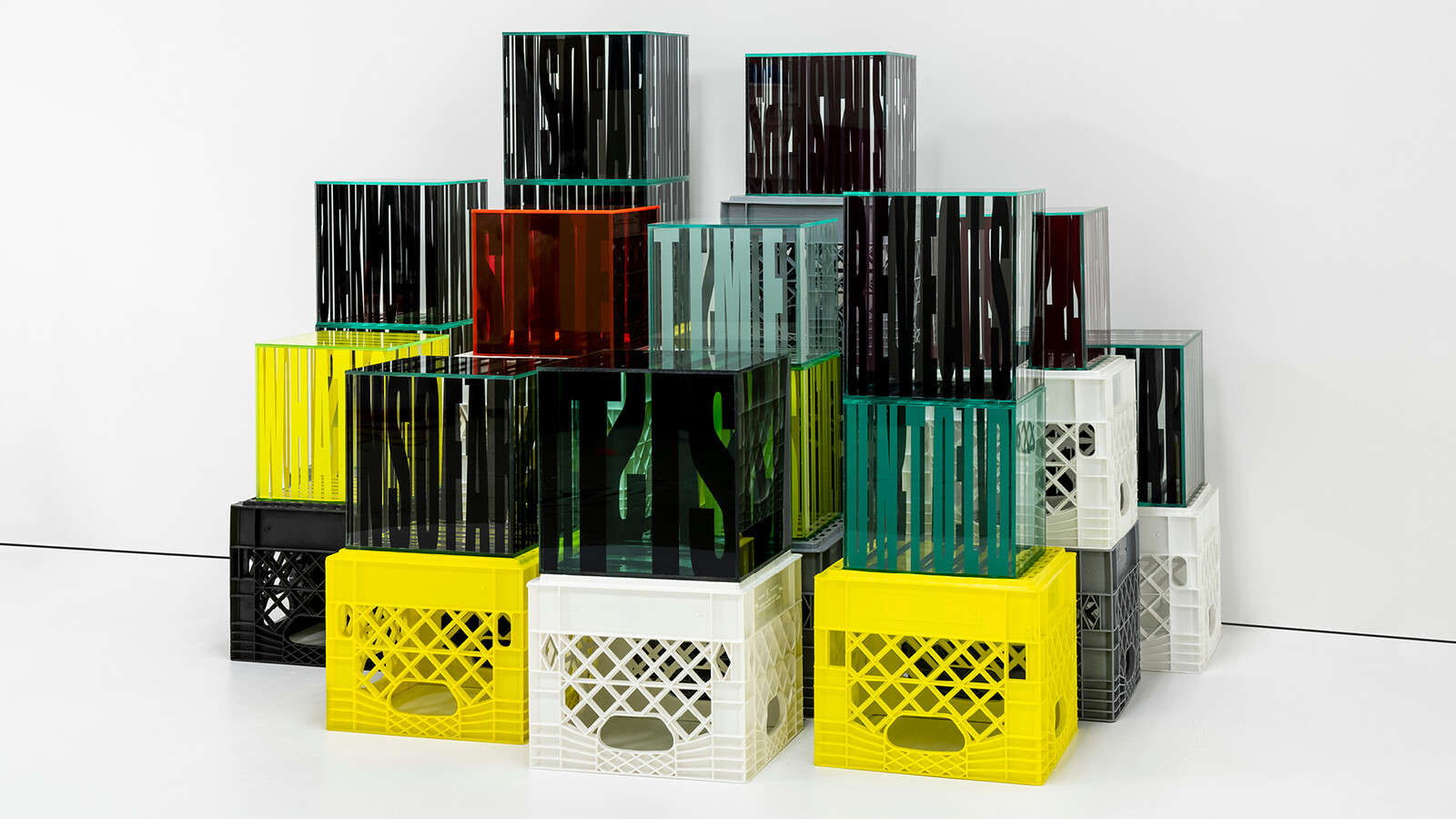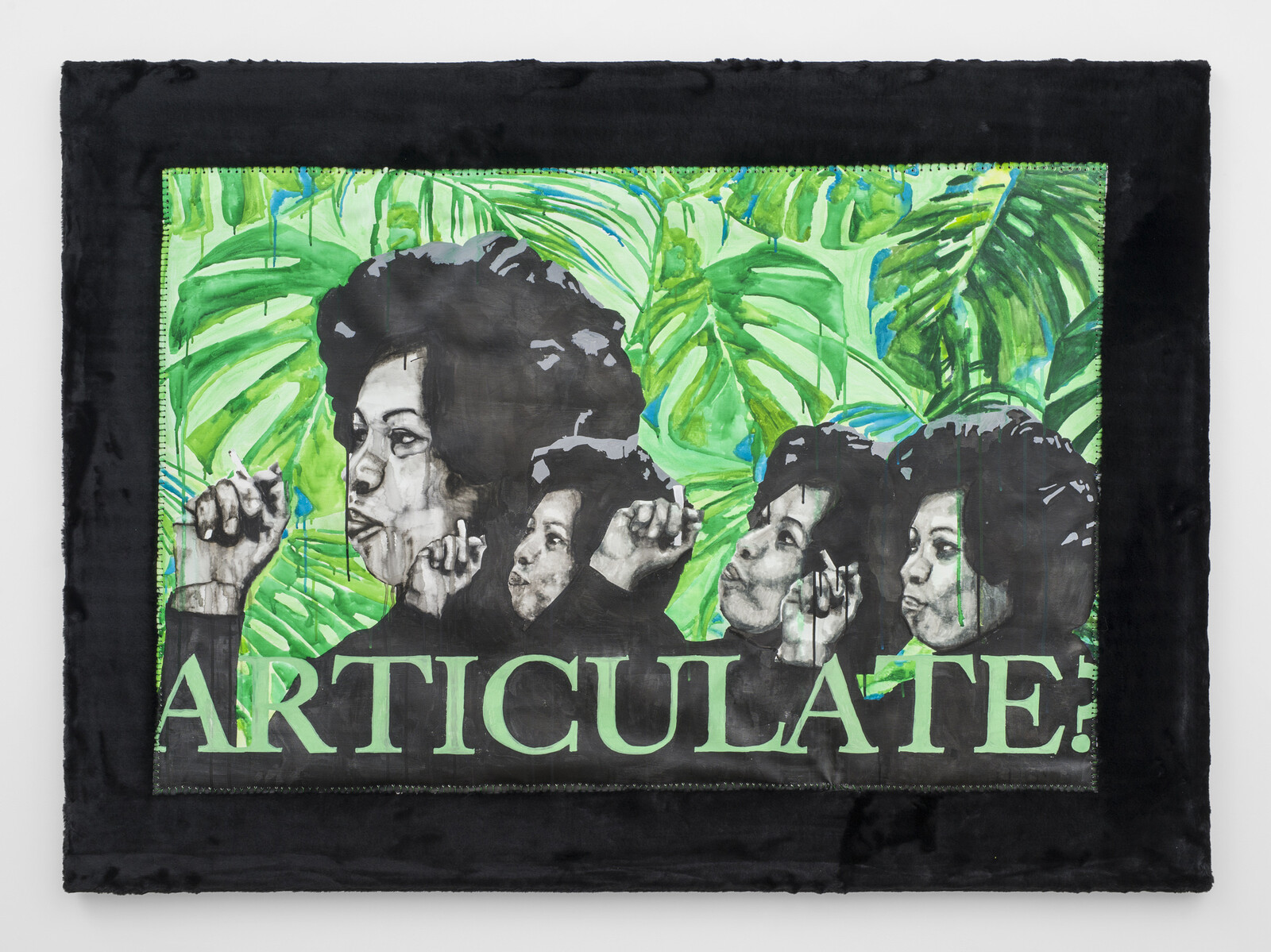March 4–August 27, 2023
Scottsdale Museum of Contemporary Art (SMoCA) presents Language in Times of Miscommunication featuring artwork that incorporates various forms of language (poetry, speculative fiction, and slang), modes of communication (propaganda, protest, social media, and advertising), and research materials (archives, political documents, and the news) that together form a timely exchange about the slippery relationship between opinion, fact, and fiction, within the construct of our collective reality.
Yuval Noah Harari, author of Sapiens: A Brief History of Humankind, argues that homo sapiens surpassed other species by creating complex languages, giving them the ability to articulate “things that exist purely in [the] imagination, such as gods, states, money, and human rights.” Over thousands of years of social evolution, human perception actualized fictions as core principles of civilization, reinforcing imagined hierarchies of power and influence. By examining past events and current actions through art that is critical of social reality we can begin to reveal the fictions that have informed society as we know it.
While this line of inquiry resonates globally, Language in Times of Miscommunication focuses on the United States to consider how the nation’s polemic atmosphere and increasingly divided reality is information by the redefinition of truth (reality that is possibly outside of human comprehension) as that which upholds personal ideology. Removed from the constraints of social agreement and systems of belief, as proposed by Trinh T. Minh-Ha in her book When the Moon Waxes Red, art critical of social reality can critique and deconstruct social norms by offering divergent perspectives. “To disrupt the existing systems of dominant values,” Trinh T. Minh-Ha writes, we must “see through the revolving door of all rationalizations” and “meet head on the truth of that struggle between fictions.” From this position, contemporary art can put forward a critical analysis of how divisive language and alternative narratives have unraveled U.S. society since 2016—a year that marked a shift in acknowledging the fallibility of communication.
Through the formats of exhibition, catalog, and special projects, Language in Times of Miscommunication acts as a platform to question how social fictions are created, interpreted, and, often, miscommunicated. Featuring work by Kristin Bauer, April Bey, Andrea Bowers, York Chang, Jeremy Dean, Jeffrey Gibson, Jenny Holzer, Christopher Jagmin, Glenn Ligon, Patrick Martinez, Elizabeth Moran, Ann Morton, Polymode, William Powhida, Kameelah Janan Rasheed, Horacio Rodriguez, Safwat Saleem, and Anna Tsouhlarakis.
Organized by Scottsdale Museum of Contemporary Art and curated by Lauren R. O’Connell, curator of contemporary art, with Keshia Turley, curatorial assistant. Exhibition support provided by Presenting Partners Walter and Karla Goldschmidt Foundation, Presenting Sponsors Mark J. and Elizabeth L. Kogan Family Trust, and Supporting Sponsor Peggy Sharp.
Special projects
Conceptual exhibition catalog
The studio Polymode designed the Language in Times of Miscommunication catalog as a twofold object, publication and artwork, that clearly relays information while simultaneously conveying notions of intentional and unintentional miscommunication. Through this experimental approach, Polymode progressively complicates the visual reception of information in the catalog, oscillating between moments of clarity and distortion.
Public interventions
Anna Tsouhlarakis’s The Native Guide Project (2019–ongoing) draws on the pedagogy of positive reinforcement to address microaggressions toward Indigenous peoples. Tsouhlarakis fashions the statements in black block lettering on a white background to challenge the stereotypes of Indigenous art and circulates them in public spaces—billboards and social media—to form a new language that propels Native American identity toward future possibilities.
Evolving timeline
William Powhida’s large-scale installation Possibilities for Representation (2020–ongoing) presents a visual timeline of America’s political history, from settler-colonial days through the present and into possible futures. Individual paintings portraying significant figures and major events (both real and fictional) are strategically hung within a spectrum of political extremes. With each presentation, the artist updates the timeline with current U.S. political events, most recently the 2022 midterm elections, to offer an array of possible outcomes for our consideration.
Poetic simulation
York Chang’s printed series of factographs (2017–19) show reconfigured images and texts cut out of newspapers to reveal how pairing the two without context can alter meaning and offer poetic reinterpretations of reality. In one of many forms of presentation, Chang installs the factographs as newsprints scattered and stacked on the gallery floor, visualizing the excessive and transient nature of information (and misinformation) in the media.








